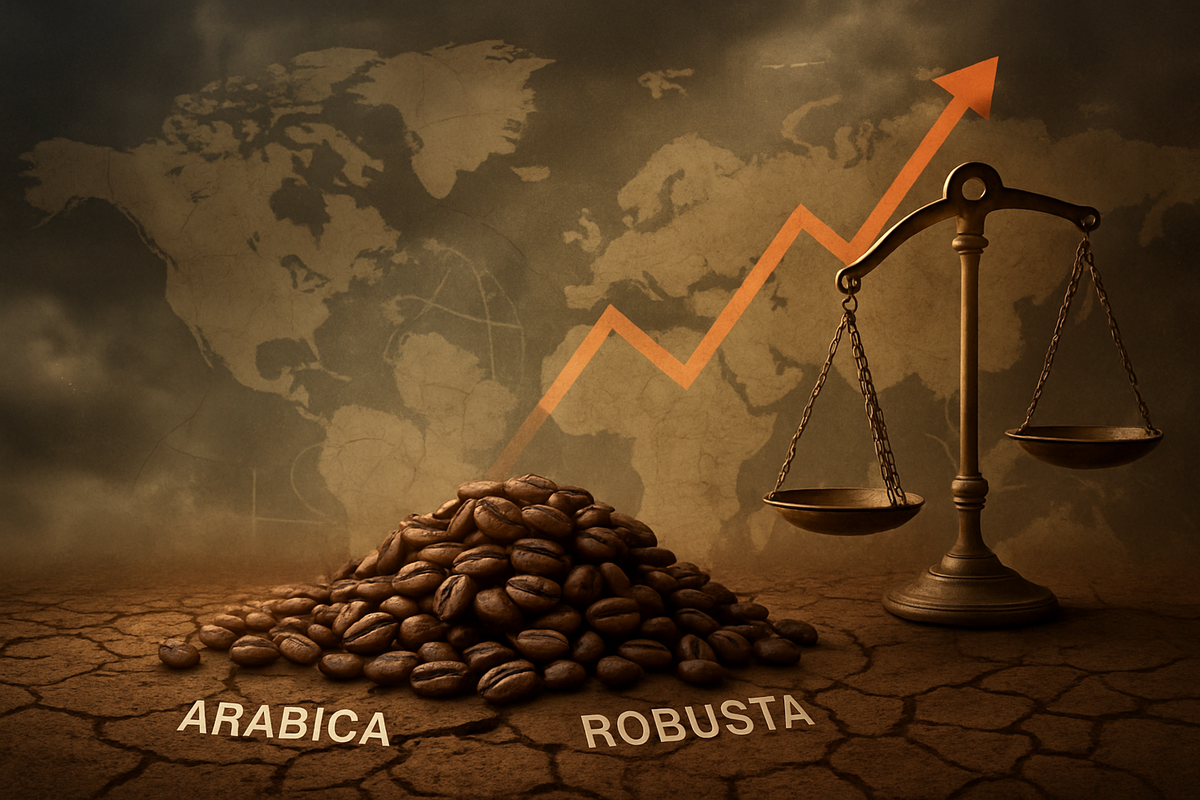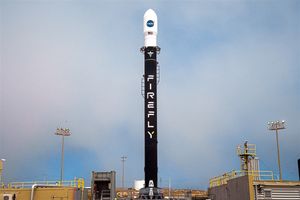Financial News
Coffee Prices Surge as ICE Inventories Plummet, Signaling Deeper Market Woes

The global coffee market is currently experiencing a significant and sustained price surge, with both Arabica and Robusta coffee futures climbing to multi-year highs. This ascent is primarily fueled by rapidly shrinking inventories on the Intercontinental Exchange (ICE), a critical indicator of global supply. December Arabica coffee (KCZ25) has seen notable increases, while November ICE Robusta coffee (RMX25) has also surged, with robusta reaching levels not seen in decades. This tightening of physical supplies, coupled with a confluence of adverse weather, trade policies, and rising operational costs, is creating immediate and profound implications across the entire coffee industry, from producers and roasters to the daily consumer.
Detailed Coverage: A Perfect Storm Brews in the Coffee Market
The current coffee price surge is the culmination of a series of events and systemic pressures that have tightened global supply. Arabica coffee futures, the global benchmark, reached a peak of $4.24 per pound on September 16, 2025, and the International Coffee Organization's (ICO) Composite Indicator Price (I-CIP) peaked at 360.74 cents on September 15, 2025. Robusta coffee prices have similarly reached near five-decade highs.
The most critical factor driving this upward trend is the dramatic decline in ICE-monitored inventories. Arabica stocks have fallen to a 1.5-year low of 534,665 bags by October 7, 2025, from a 1.25-year low of 716,578 bags on August 27, 2025. Robusta inventories have also diminished significantly, hitting a 2.5-month low of 6,237 lots by October 7, 2025. These dwindling certified stockpiles signal a severe tightening of readily available coffee.
This situation has been exacerbated by a challenging timeline of events:
- 2021: A severe frost in Brazil, the world's largest Arabica producer, initiated the upward price trend.
- Post-Pandemic Disruptions: Ongoing supply chain bottlenecks, increased transportation costs, and geopolitical conflicts (like the Red Sea crisis impacting Robusta shipments) have intensified price instability.
- 2023-2024 Extreme Weather: Persistent droughts, heatwaves, and frosts in Brazil, alongside droughts and heavy rainfall in Vietnam (the top Robusta producer), severely damaged coffee crops. Vietnam's 2023/24 crop, for instance, saw a 20% decline.
- Late 2024/Early 2025 Trade Policies: The imposition of a 50% U.S. tariff on Brazilian coffee imports has significantly tightened U.S. supplies, further contributing to the draw-down of ICE inventories.
- Mid-to-Late 2025 Inventory Decline: Throughout August and September 2025, the sharp decline in ICE inventories became the primary driver of the ongoing price rally.
Key players and stakeholders are all feeling the impact. Coffee producers face a complex reality: while higher prices offer improved incomes, these are often offset by reduced yields and rising operational costs. Traders and exporters are navigating extreme market volatility and significant financial pressures from margin calls. Roasters and retailers are grappling with increased green bean costs, leading to either reduced profit margins or the necessity to pass these costs onto consumers. The Intercontinental Exchange (ICE) remains central, with its inventory levels serving as a crucial barometer of global supply. Consumers, ultimately, are bearing the brunt through higher retail prices.
Initial market reactions have been swift. Roasters are eliminating discounts and implementing price increases. Major chains like Tim Hortons (TSX: QSR) have already adjusted prices, while smaller roasters struggle to absorb costs, often passing them on at the risk of losing price-sensitive customers. The industry is also witnessing a rethinking of supply chain resilience, with growing discussions about long-term price management and equitable value distribution to ensure sustainability for farmers.
Corporate Impact: Winners, Losers, and Strategic Shifts
The surge in Arabica and Robusta coffee prices presents a bifurcated landscape for public companies within the coffee industry. While some are effectively mitigating losses or even capitalizing on the situation, others face significant financial pressures.
Among the companies facing headwinds is Keurig Dr Pepper (NASDAQ: KDP), where coffee accounts for approximately one-third of its sales. The company has implemented price increases but anticipates lower gross profit margins for 2025 as higher-cost green coffee hedges mature. KDP's U.S. coffee business has reported declining sales, and its stock has tumbled, reflecting investor concerns. The company is actively evaluating options to offset rising green coffee costs and tariffs.
Starbucks (NASDAQ: SBUX), a global coffee retail giant, is directly exposed to increased bean costs and the U.S. tariffs on Brazilian coffee. The company has raised prices multiple times since 2021, with the average price of a grande brewed coffee up 49% since 2020. The 50% tariff on Brazilian coffee is expected to significantly impact costs, particularly in its ready-to-drink and packaged divisions, potentially affecting earnings per share. Starbucks is expanding its supply chain and investing in Central American coffee farms to counteract these impacts.
J.M. Smucker Co. (NYSE: SJM), producer of brands like Folgers and Café Bustelo, is also grappling with high costs. While price increases have boosted its U.S. coffee division's revenue, profit margins have suffered, falling 300 basis points as inflation outpaced adjustments. The company anticipates further tariff-driven cost increases and is working on alternative sourcing strategies, expecting higher prices to temper sales volume.
Conversely, companies with strong pricing power, effective hedging, and diversified sourcing are better positioned. Nestlé (SWX: NESN), the global food and beverage giant, has demonstrated an ability to navigate rising costs by passing them on to consumers. Its coffee segment saw 5.1% organic growth in early 2025, driven by price increases that offset lower demand. Nestlé is focusing on optimization, cost-saving measures, and leveraging its leading coffee brands (Nescafé, Nespresso, licensed Starbucks) for growth.
JDE Peet's (AMS: JDEP), parent company of Douwe Egberts and Jacobs, reported impressive revenue growth in the first half of 2025, almost entirely due to price increases of 21.5%. Despite soaring green coffee costs, the company's profit also rose, and it expects further "additional pricing" and significant cost cuts. JDE Peet's has effectively passed on price increases, even amidst conflicts with supermarket chains.
Coffee growers, particularly in regions with good harvests, can be considered potential "winners" in the short term. For example, Colombia experienced its best coffee harvest in over three decades, with the value of its exports jumping significantly due to high international prices. However, this benefit is often tempered by reduced yields in other regions and rising input costs, making the situation complex for many smallholder farmers.
Wider Significance: A Climate-Driven Commodity Crisis
The current coffee price surge, driven by shrinking ICE inventories, is more than a fleeting market anomaly; it represents a significant symptom of broader, long-term industry trends. This event underscores coffee's inherent vulnerability as an agricultural commodity, particularly to climate change, and highlights systemic pressures throughout its global supply chain.
The most pervasive trend is climate change and weather volatility. Extreme weather events—droughts, frosts, and heatwaves in Brazil, and droughts and heavy rainfall in Vietnam—are consistently reducing crop yields and impacting coffee quality. Climate change is projected to shrink suitable coffee cultivation areas by up to 50% by 2050. The recent dry conditions in Brazil, among the worst since 1981, fuel fears for future crops, a concern amplified by the increased likelihood of a La Niña weather system.
Despite these supply challenges, global demand for coffee continues to rise, particularly in emerging markets like China and India, where coffee culture is expanding. This growing consumption puts additional pressure on an already constrained supply. Furthermore, supply chain disruptions, including shipping delays, port congestion, and rising transportation costs (exacerbated by events like the Red Sea crisis), continue to tighten coffee availability and inflate prices.
The ripple effects are profound. Coffee roasters and retailers face immense pressure, often forced to raise consumer prices, which risks customer alienation. Smaller roasters are particularly vulnerable due to less leverage in sourcing and pricing. Producers, while potentially benefiting from higher prices, often see these gains offset by lower yields and increased input costs. The entire supply chain, from warehouses near ports to individual traders, is adapting to tight supplies and volatile conditions.
From a regulatory standpoint, the U.S. tariffs on Brazilian coffee exemplify how policy can directly impact trade flows and ICE inventories, leading to market distortions. The impending European Union Deforestation Regulation (EUDR) is also influencing buying behavior, pushing roasters to secure compliant supplies in advance and adding demand pressure. These regulations signify a broader shift towards more sustainable and ethically sourced commodities, albeit with initial market friction.
Historically, the coffee market has a long history of price volatility. The "Black Frost" of 1975 in Brazil caused the most dramatic price spike in modern history, devastating crops and sending green coffee prices soaring. Similarly, the 2010-2011 surge was driven by extreme weather in Brazil and Colombia, alongside rising demand and speculation. These precedents demonstrate that severe weather events in Brazil often trigger significant price spikes, and market speculation can amplify these movements. The current crisis, mirroring these historical patterns, reinforces the idea that coffee will likely remain more expensive and volatile in the long term due to structural factors like climate change.
What Comes Next: Navigating a Turbulent Future
The path forward for the coffee market is fraught with both challenges and opportunities, demanding strategic pivots from all stakeholders. The short-term outlook suggests continued volatility, while the long-term view is dominated by climate change and evolving consumption patterns.
In the short-term (next 6-12 months), prices are expected to remain volatile, with sharp spikes likely due to ongoing climate disasters and supply chain bottlenecks. Weather forecasts for Brazil will be a primary determinant of price action. While some experts anticipate a potential price correction for Arabica (8-30% decline by end of 2025) and Robusta, driven by expectations of larger crops in the 2026/27 season and potentially dampened demand, the 71% likelihood of a La Niña weather system from October to December 2025 could bring excessive dry weather to Brazil, harming the 2026/27 crop and potentially leading to further price increases. The 50% U.S. tariffs on Brazilian coffee will also continue to tighten U.S. supplies unless revised.
The long-term (beyond 12 months) outlook points to continued growth in global coffee demand, projected to reach USD 174.25 billion by 2030. However, climate change remains the most significant long-term threat, particularly for Arabica, which is sensitive to specific growing conditions. This will likely lead to continued price volatility and shifts in traditional growing regions. The market is expected to exhibit cyclical behavior, with sharp price spikes recurring every 5-10 years.
To navigate this turbulent future, strategic pivots and adaptations are critical. Businesses must prioritize diversified sourcing to mitigate supply chain shocks and reduce reliance on vulnerable regions. Investing in sustainable and climate-resilient agricultural practices at the farm level is crucial, including soil management and disease-resistant varieties. Technology integration, such as precision agriculture and blockchain for transparency, can improve resource management. Roasters and coffee shops will need strategic pricing and inventory management, potentially passing on costs while transparently communicating challenges to consumers. A focus on value creation through quality, unique flavors, and ethical sourcing, especially in the specialty coffee segment, will also be vital.
Market opportunities include the rapidly growing specialty coffee market (projected to reach USD 183.0 billion by 2030), expanding consumption in emerging markets (Asia, Middle East), and the continued growth of ready-to-drink (RTD) and at-home coffee products. However, significant challenges persist, including the pervasive threat of climate change, ongoing price volatility, fragile supply chains, increasing regulatory pressures (like the EUDR), and economic headwinds.
For Arabica futures, continued bullish pressure is likely in the near term due to low ICE inventories and U.S. tariffs, though rainfall forecasts in Brazil could offer temporary relief. Volcafé projects a widening Arabica deficit for 2025/26. For Robusta futures, near-term surges are expected due to low ICE inventories and potential crop damage in Vietnam. While USDA FAS projects an increase in robusta production for 2025/26, its greater resilience to harsher conditions might make it a more stable option long-term, driving sustained demand.
Wrap-Up: A New Era of Volatility and Adaptation
The current coffee price surge, driven by critically shrinking ICE inventories, marks a pivotal moment for the global coffee market. It's a stark reminder of coffee's vulnerability as a commodity, exposed to the relentless pressures of climate change, geopolitical shifts, and economic forces. This period of unprecedented volatility is forcing a fundamental reassessment of how coffee is produced, traded, and consumed.
Key takeaways from this event include the record-high prices for both Arabica and Robusta, the dramatic decline in ICE-certified stocks signaling acute physical shortages, the devastating impact of adverse weather in major producing nations (Brazil and Vietnam), and the disruptive influence of U.S. tariffs on Brazilian coffee. The market's "backwardation" further underscores immediate supply tightness, while the narrowing price differential between Arabica and Robusta highlights the broad-based nature of the supply crunch.
Moving forward, the coffee market is expected to remain highly volatile. While some forecasts suggest potential price corrections by late 2025 or 2026, the underlying structural supply constraints, particularly the projected widening Arabica deficit, indicate that significant price fluctuations will persist. Any further major supply disruptions, whether from weather or trade policies, could send prices soaring again. The long-term trajectory is shaped by increasing global demand colliding with climate-induced production instability.
The lasting impact of this period will be a heightened focus on supply chain resilience, sustainable sourcing, and strategic risk management across the industry. Roasters and retailers face the ongoing challenge of balancing rising input costs with consumer price sensitivity, potentially leading to shifts in product offerings and sourcing origins. For producers, the crisis underscores the urgent need for climate-resilient farming practices and fair compensation to ensure the long-term viability of coffee cultivation.
Investors should closely watch several key indicators in the coming months. Foremost are ICE inventory levels for both Arabica (KC) and Robusta (RM) – any further drawdowns will maintain bullish pressure. Weather patterns in key producing regions, especially Brazil during Arabica flowering and Vietnam for Robusta, will be critical, particularly given the potential for a La Niña system. Updated crop forecasts and export data from agencies like Conab and the USDA, alongside figures from the ICO and national trade ministries, will provide vital insights into future supply. Developments regarding U.S. tariffs on Brazilian coffee could significantly impact U.S. supply. Finally, monitoring global demand trends, shipping costs, geopolitical events, and speculative positioning will be crucial for navigating this complex and dynamic market.
This content is intended for informational purposes only and is not financial advice.
More News
View More





Quotes delayed at least 20 minutes.
By accessing this page, you agree to the following
Privacy Policy and Terms Of Service.



